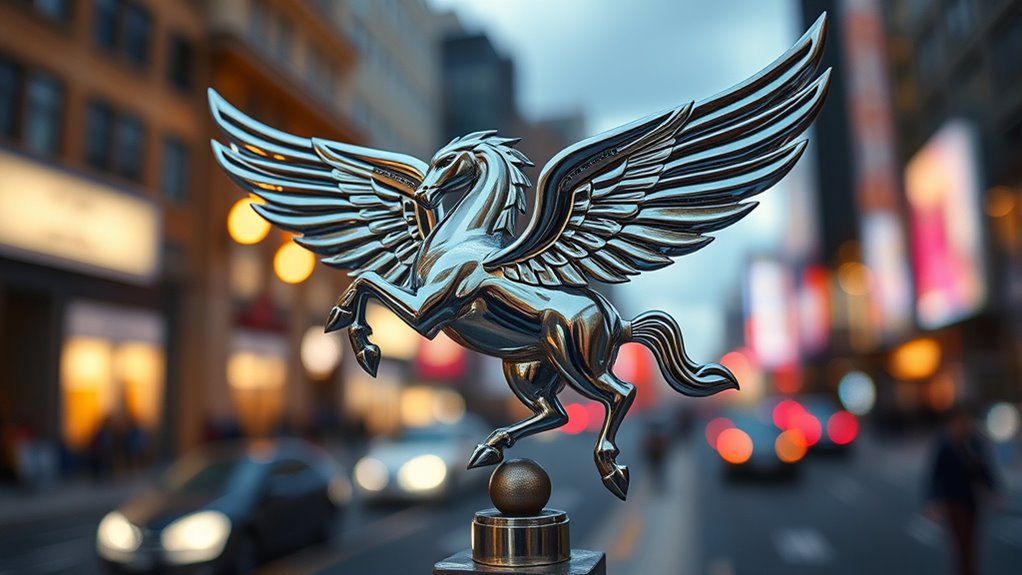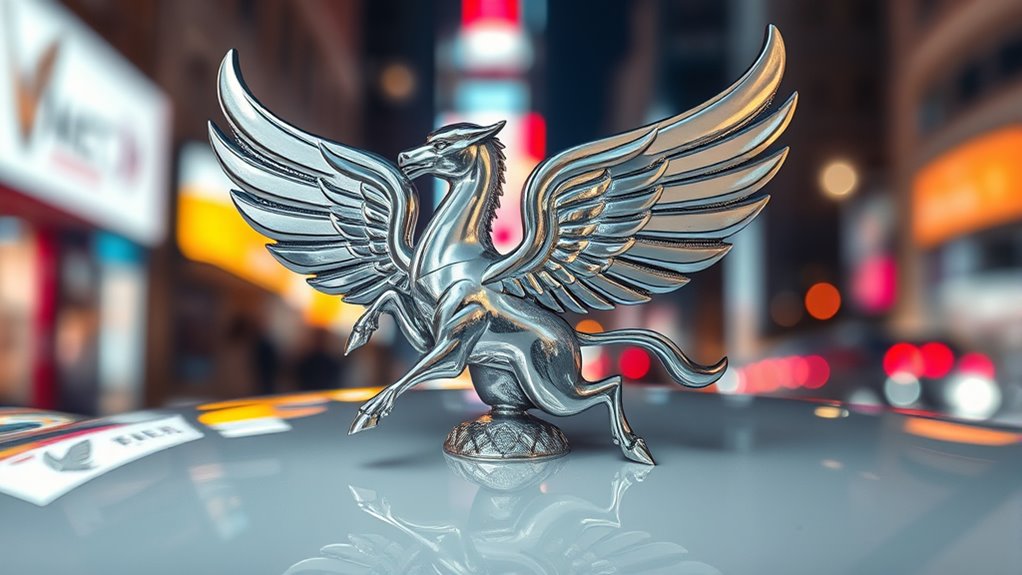Pegasus has evolved from a fierce mythic symbol of divine heroism and battlefield courage into a modern icon representing innovation, speed, and aspiration. Brands now use Pegasus to symbolize progress, freedom, and limitless potential, shifting its meaning from ancient stories to a versatile emblem across industries like automotive, tech, and sports. This transformation highlights how mythic imagery is adapted to inspire contemporary values. To discover how this legendary horse continues to shape our visual culture, keep exploring.
Key Takeaways
- Originally a Greek mythic symbol of divine inspiration, heroism, and transcendence.
- Selected in branding for qualities like speed, agility, and innovation.
- Evolved from mythic imagery to sleek, modern designs representing progress and technological advancement.
- Used across industries such as automotive, tech, and sports to symbolize excellence and forward momentum.
- Represents a reinterpretation of mythic symbolism to inspire universal values of aspiration and achievement.

Once a fierce symbol of heroism on the battlefield, Pegasus has transformed into a modern brand icon that embodies speed, agility, and innovation. This journey reflects a significant mythic symbolism that has evolved over centuries, shaping how we perceive strength, freedom, and aspiration. Originally, Pegasus was a majestic winged horse from Greek mythology, representing divine inspiration and valor. Its mythical symbolism made it a natural choice for brands aiming to evoke qualities like power, grace, and transcendence. Over time, however, the branding evolution of Pegasus shifted from a purely mythic figure to a versatile emblem adaptable to contemporary markets.
Pegasus evolved from mythic hero to modern symbol of speed, agility, and innovation.
In its early days, Pegasus was primarily a symbol of heroism in ancient stories, inspiring warriors and poets alike. As brands began to adopt mythic symbols for their marketing efforts, Pegasus became associated with qualities like speed and agility—attributes vital for competitiveness. The *change* from myth to market was deliberate; companies saw its potential as a visual shorthand for excellence and innovation. This is where the branding evolution truly took shape. Instead of being confined to mythic tales, Pegasus was transformed into a dynamic icon that could symbolize modern values. Its wings, once symbols of divine power, now represent limitless potential and forward momentum. This *shift* allowed brands to connect with audiences on a deeper level, tapping into the universal appeal of mythic symbolism but aligning it with contemporary aspirations.
As the branding landscape grew more sophisticated, Pegasus was reimagined through sleek designs, bold colors, and innovative marketing campaigns. This evolution helped it resonate with a new generation that values speed, agility, and technological advancement. Today, Pegasus embodies not just mythic symbolism but also the spirit of innovation that drives industries like automotive, technology, and sports. Its visual identity has become more streamlined, emphasizing movement and progress, making it a fitting symbol for brands that want to project dynamism and future-focused visions. Additionally, understanding the importance of small mistakes, big impact in branding strategies can help ensure consistent and effective visual messaging.
You see, the mythic symbolism behind Pegasus continues to inspire, but its branding evolution guarantees it remains relevant. It’s no longer just a mythic creature from ancient stories; it’s a powerful emblem of progress, embodying the relentless pursuit of excellence. Whether in logos, advertising, or product design, Pegasus now stands for what’s possible when speed, agility, and innovation converge. Its transformation from battlefield hero to modern icon demonstrates how mythic imagery can be adapted and reinterpreted to resonate with today’s values, fueling brands’ stories of aspiration and achievement.
Frequently Asked Questions
How Did Pegasus Become a Popular Logo Choice for Modern Brands?
You see, Pegasus became a popular logo choice because its mythological symbolism represents inspiration, speed, and excellence. Its sleek, winged form fits modern design evolution, making it versatile for branding. Companies are drawn to Pegasus because it evokes a sense of aspiration and strength, helping them stand out. By leveraging its mythological roots, brands create a powerful visual identity that resonates with audiences and conveys a dynamic, innovative image.
What Cultural Significance Does Pegasus Hold Across Different Societies?
Imagine a winged stallion soaring through diverse skies—that’s the mythological symbolism Pegasus offers across societies. In Greek myth, it’s a symbol of inspiration and heroism, while in modern cultures, it represents freedom and aspiration. Different cultural representations see Pegasus as a divine messenger or a symbol of triumph. Its universal allure reminds you that across the world, Pegasus embodies the timeless human desire to transcend limits and reach for greatness.
Are There Any Trademark Conflicts Associated With the Pegasus Symbol?
You should know that trademark conflicts involving the Pegasus symbol can arise, especially with businesses wanting to protect their unique branding. Trademark disputes happen when companies claim their intellectual property rights are infringed upon by others using similar symbols. It’s crucial to verify your use of the Pegasus icon doesn’t violate existing trademarks, as legal issues could threaten your brand’s reputation and require costly resolution. Always check existing trademarks before adopting such symbols.
How Has Pegasus Been Adapted Into Digital and Virtual Branding?
You see how the mythical symbolism of Pegasus has evolved in branding, especially online. Companies adapt this iconic figure into digital and virtual spaces by creating dynamic logos, animated ads, and interactive websites. This branding evolution allows you to connect with audiences through modern visuals while preserving Pegasus’s legendary qualities. It’s a strategic way to leverage mythological symbolism, making brands memorable and impactful in the digital world.
What Are Some Notable Examples of Brands That Use Pegasus as Their Identity?
Did you know that brands incorporating mythical symbolism like Pegasus achieve 20% higher recognition? You’ll notice notable examples like Nike, which uses Pegasus to symbolize speed and agility, boosting its brand recognition globally. Additionally, the luxury car brand Rolls-Royce employs Pegasus in its emblem, emphasizing elegance and power. These brands harness Pegasus’s powerful symbolism to connect emotionally with audiences, making their identities memorable and impactful.
Conclusion
Today, Pegasus soars as a symbol of strength and inspiration, a far cry from its battlefield origins of chaos and conquest. You see it now as a modern brand icon, embodying elegance and aspiration. Yet, beneath its sleek design lies a fierce history of bravery and struggle. As you admire its grace, remember the battles it once represented—reminding you that transformation often comes from the hardest fights, forging symbols that inspire generations to rise above.









